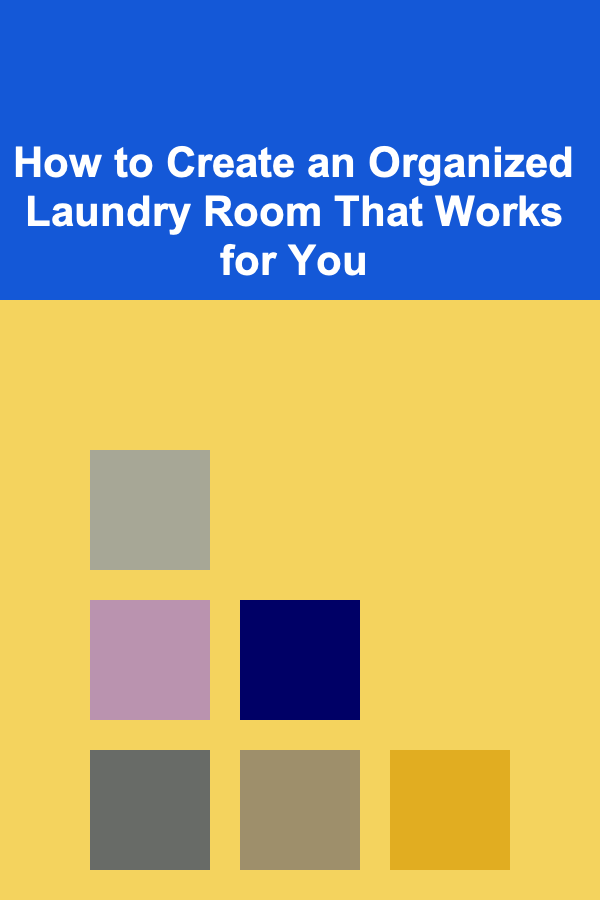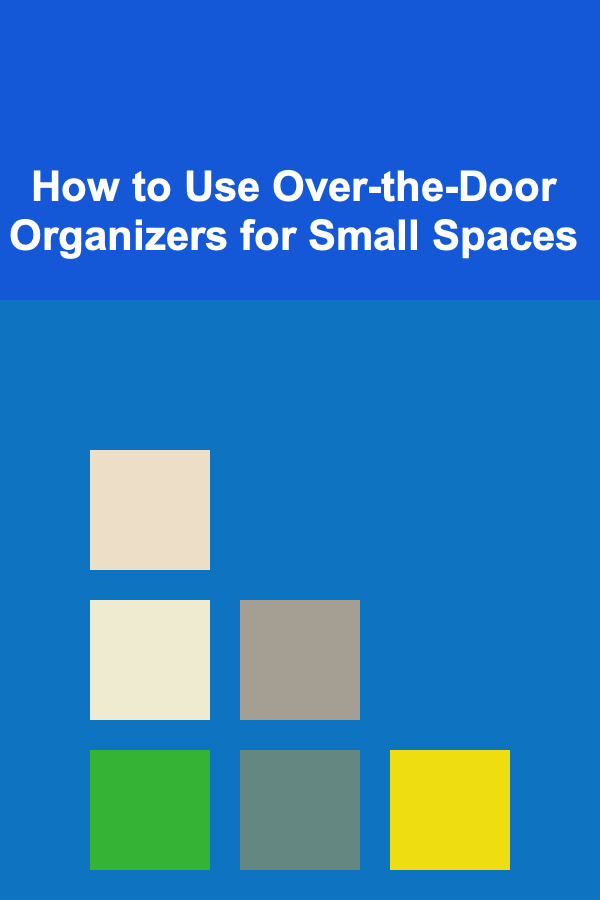
How to Store Your Kids' Toys Without Taking Over the House
ebook include PDF & Audio bundle (Micro Guide)
$12.99$10.99
Limited Time Offer! Order within the next:

Managing your kids' toys can quickly feel like an overwhelming task. Toys seem to multiply overnight, and suddenly, your living space is cluttered with dolls, trucks, building blocks, and stuffed animals. The constant battle between trying to maintain an organized home and ensuring your children have easy access to their toys is a common dilemma for many parents.
If you feel like the toys are taking over your house, you're not alone. But, with a bit of creativity, organization, and smart storage solutions, you can reclaim your space while still keeping your kids' toys accessible and enjoyable for them. This article will guide you through the process of effectively storing your kids' toys without compromising your home's appearance or functionality.
Understanding the Importance of Toy Storage
Before diving into the "how," it's essential to understand why effective toy storage matters. The clutter of toys can have a significant impact on both parents and children. For parents, a cluttered home can lead to stress, frustration, and a constant feeling of disarray. For children, having too many toys scattered around can create a sense of overwhelm, making it difficult for them to play and focus on one thing at a time.
Well-organized toy storage offers several benefits:
- Reduces clutter: An organized space makes your home feel tidier and less chaotic.
- Promotes independence: When kids can easily find and put away their toys, they develop organizational skills and learn to take responsibility for their belongings.
- Encourages creative play: With toys organized in a way that's easy for children to access, they're more likely to engage in thoughtful, creative play.
- Improves safety: Having a clear place for everything ensures that toys won't be left on the floor, reducing the risk of tripping and accidents.
With these benefits in mind, let's explore various practical ways to store your kids' toys.
Assess the Toy Situation
Before you begin the actual process of organizing, it's important to take stock of the toys you have. Kids often accumulate toys over time---birthday presents, hand-me-downs, and impulse buys all contribute to the clutter. To truly solve the problem, you must start by evaluating and decluttering.
Declutter and Sort
Start by going through each toy and asking the following questions:
- Is this toy still age-appropriate? Kids grow quickly, and some toys may no longer be suitable for their developmental stage.
- Do they play with this toy? If a toy hasn't been played with in months or years, it might be time to let it go.
- Is it broken or missing pieces? Toys that no longer function as they should should be recycled or thrown away.
- Does it spark joy? Inspired by Marie Kondo's decluttering method, ask if the toy brings any positive emotions to your child's life. If not, it's time to let it go.
After decluttering, categorize the toys into groups. You can sort them based on type (e.g., dolls, cars, educational toys, etc.) or size. This categorization will guide you in choosing the right storage solutions.
Decide on What to Keep
Once you have a clear understanding of what you're working with, decide what toys should remain and which ones should be donated or discarded. Keep in mind that the goal is not to get rid of everything but to create a manageable collection of toys that fit well in your living space.
Choose the Right Storage Solutions
Now that you've decluttered and sorted the toys, it's time to find storage solutions that work for your home. There are many options available, and the key is to find systems that are both practical and accessible for your kids.
3.1 Toy Bins and Baskets
One of the simplest and most effective ways to store toys is by using bins or baskets. These storage solutions come in all shapes and sizes, making it easy to find something that fits your space and style.
- Open Bins: Open bins are ideal for toys that your kids play with regularly. Label each bin according to the type of toys it holds (e.g., "Legos," "Stuffed Animals," "Action Figures"). This encourages kids to put their toys away independently.
- Stackable Bins: Stackable bins allow for vertical storage, which is ideal for small spaces. You can stack several bins of varying sizes on top of each other to create a compact and organized toy storage system.
- Decorative Baskets: For a more aesthetically pleasing option, choose woven baskets or fabric bins. These can blend into your home decor while still offering practical storage for toys.
3.2 Toy Storage Cabinets or Shelves
For a more permanent and structured solution, toy storage cabinets or shelves are a great option. These pieces of furniture can house a variety of toys, from books to action figures, while keeping things off the floor.
- Cubby Storage: Cubby storage systems are a great way to separate toys into individual sections. Each cubby can house a different category of toys, and you can label them to make it easier for kids to find what they're looking for.
- Bookshelves: If your child has a lot of books or small toys, a bookshelf can double as both a toy and book storage solution. Bookshelves with low shelves are especially helpful for young kids to reach their toys and books independently.
- Wall-Mounted Shelves: If floor space is at a premium, consider installing wall-mounted shelves. These can be used for smaller toys, and higher shelves can be reserved for items that are only occasionally used.
3.3 Toy Chests and Storage Benches
Toy chests and storage benches are a popular choice for storing toys in a more discreet way. These larger storage units can hold a variety of toys and are often designed with lids, which helps keep things out of sight.
- Toy Chests: A classic toy chest can house a wide variety of toys and is an excellent option for storing larger or softer items. Some toy chests come with safety features like soft-close hinges to avoid pinched fingers.
- Storage Benches: A storage bench can serve a dual purpose as both a seating area and a place to store toys. This is particularly useful in playrooms or bedrooms where space might be limited.
3.4 Under-Bed Storage
One often-overlooked storage area is under the bed. If your child's bed has space beneath it, this area can be transformed into valuable storage.
- Storage Bins on Wheels: Place large plastic bins with wheels under the bed to store toys. These bins can be pulled out easily and pushed back under the bed when not in use.
- Drawers or Baskets: Some beds come with built-in drawers that provide additional storage. Alternatively, baskets can be used to store toys that are not used every day.
3.5 Over-the-Door Organizers
Over-the-door organizers are a space-saving solution for small rooms. These can be used to store toys like action figures, dolls, or craft supplies, and they take up minimal space.
- Pockets or Hooks: Look for organizers with clear pockets or hooks to store toys that can easily be hung. These are great for lightweight toys that your child uses frequently.
- Hanging Baskets: If your child has a collection of small toys or stuffed animals, hanging baskets can be a great option. These baskets are lightweight and can hold several toys at once.
Make Toy Storage Fun for Kids
Getting kids involved in organizing their toys not only helps with the overall process but also teaches them valuable lessons in responsibility and tidiness. Here are a few ideas for making toy storage fun and engaging for children:
4.1 Color-Coded Storage
Color coding storage bins can make organizing toys a fun and educational activity. Assign a color to each type of toy, and teach your kids to place their toys in the corresponding colored bin. This approach encourages categorization and can help your child learn about colors and sorting.
4.2 Labeling and Pictures
Labels are a great way to make toy storage accessible and easy for young children. If your child is not yet reading, use pictures or illustrations on the storage bins to indicate which toys go where. This visual guide makes it easier for kids to identify where to store their toys.
4.3 Toy Rotation System
Instead of storing all the toys out in the open, try implementing a toy rotation system. This involves storing some toys away for a few weeks or months, rotating them in and out of use. When toys are rotated, they feel like new, and your child is more likely to stay engaged with them.
Maintain Organization Over Time
The key to successful toy storage is consistency. Regularly reassess the toys your child no longer plays with, and make sure to keep the storage system organized. Here are a few tips to maintain order in your toy storage system:
- Weekly Tidying: Spend a few minutes each week going through the toys with your child, ensuring they're put away correctly.
- Teach Kids to Clean Up: Encourage your children to clean up after playtime. Make it a fun ritual, perhaps by setting a timer and seeing how fast they can put away their toys.
- Donate Regularly: As your child grows, their toy preferences will change. Regularly donate or sell toys that no longer serve their purpose to prevent clutter from building up.
Conclusion
Storing kids' toys without taking over your house requires a combination of smart storage solutions, decluttering, and involving your children in the process. By choosing the right storage options and making organization a fun and consistent habit, you can keep your home tidy while ensuring that your kids have access to their favorite toys. Remember, the key to maintaining a clutter-free space is not only organizing but also regularly assessing and adjusting the storage system as your child's needs and toys evolve. With a little effort, your home can remain organized, and your kids will still have a space full of fun and creativity.

How to Create a Stylish Entryway with Low-Cost Decor
Read More
How to Create an Organized Laundry Room That Works for You
Read More
How to Use Credit Cards Responsibly to Boost Your Credit Score
Read More
How to Use Over-the-Door Organizers for Small Spaces
Read More
Investing in Deep Learning Projects to Generate Long-Term Passive Income
Read More
How to Experience the Festivals of India
Read MoreOther Products

How to Create a Stylish Entryway with Low-Cost Decor
Read More
How to Create an Organized Laundry Room That Works for You
Read More
How to Use Credit Cards Responsibly to Boost Your Credit Score
Read More
How to Use Over-the-Door Organizers for Small Spaces
Read More
Investing in Deep Learning Projects to Generate Long-Term Passive Income
Read More